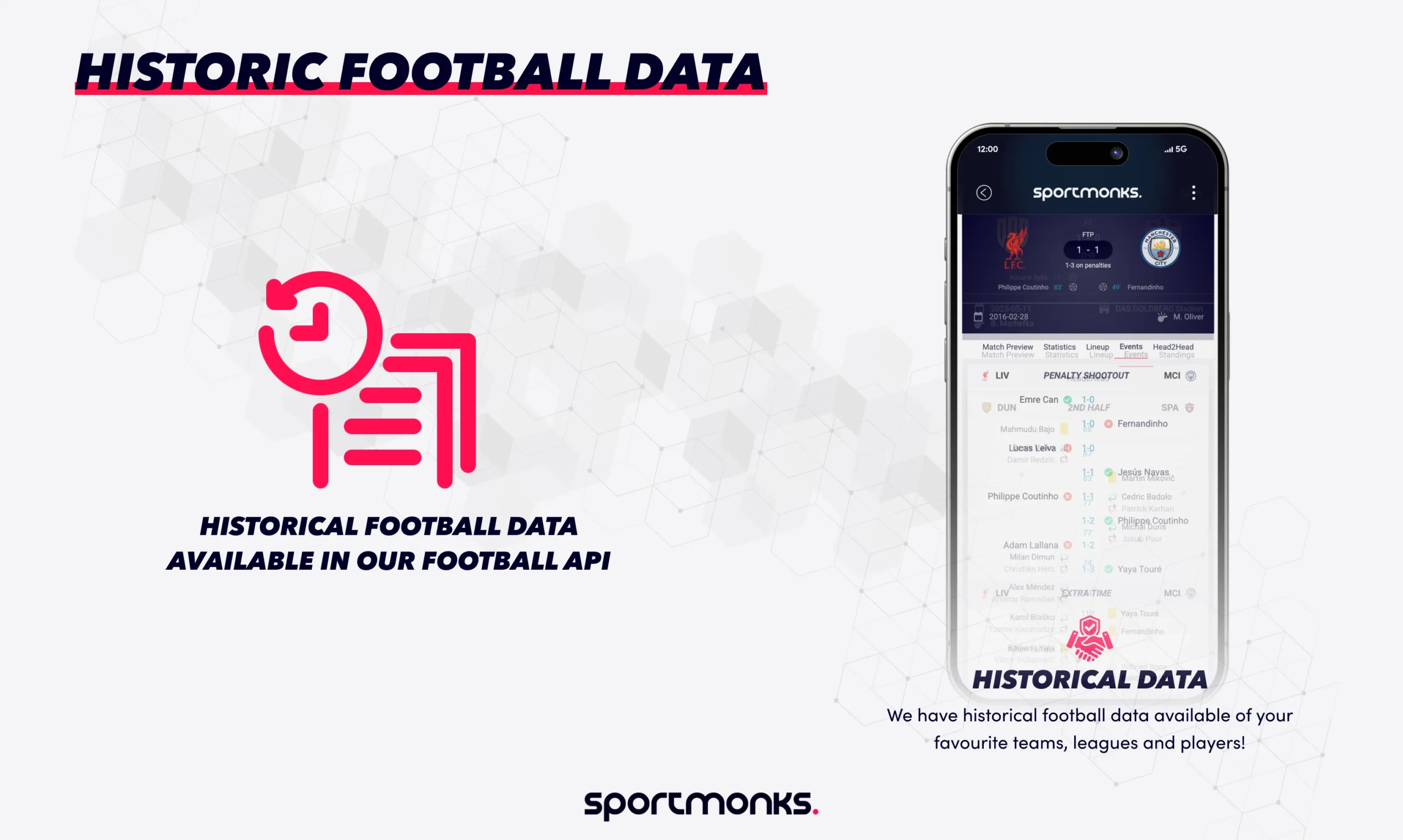
Contents
What is historical football data?
Historical football data is the collection of past information related to football, encompassing matches, players, teams, leagues, and competitions. This data spans from basic match results and goalscorers from the early days of organised football to more detailed player performance metrics in recent times. Essentially, it’s a record of how the sport has unfolded and evolved over the years, providing a foundation for understanding football’s past.
Early sources of data collection
The earliest forms of football focused on the most basic outcomes. Match reports in newspapers and early football papers recorded the final score, the winning team, and sometimes the names of the goalscorers. Stats depth was limited by the manual nature of record-keeping.
As organised football leagues and competitions became more established in the late 19th and early 20th centuries, efforts to record more detailed and comprehensive football stats began to come out. League tables, providing a cumulative record of wins, losses, draws, and points, became standard. Information on individual player appearances and goal tallies also became more documented.
The mid to late 20th century saw an increase in the scope of recorded data. Match programmes and specialist football publications started to include more statistics, such as possession percentages (though often estimated), corner kicks, and shots on target. However, the collection of this data remained largely manual and inconsistent across different sources.
A significant turning point came with the digital revolution and increased professionalism of football in the late 20th and early 21st centuries. Computerised databases and sophisticated tracking technologies allowed for the collection of more detailed data. Companies began to specialise in collecting and analysing vast amounts of information on every aspect of a football match, from individual player movements to detailed event timelines.
Types of historical football data available
Historical football data available today is extensive and continues to grow as more archives are digitised and new data sources come forth. Key categories of this data include:
– Match results and fixtures: This data includes the date, time, venue, participating teams, and the final score of matches across various leagues, competitions, and international fixtures throughout history.
– Goalscorer information: Records of which players scored goals in each match, including goal details like the minute of the goal or goal type (own goal or set-piece).
– League tables: Historical league tables track team performance over seasons, including points earned, wins, losses, draws, goals scored, and goals conceded.
– Player statistics: Individual player data, which has become increasingly detailed over time, can include appearances, goals, assists, yellow and red cards, minutes played, and, in more recent performance metrics like pass completion rates, tackles won, shots on target, and distance covered.
– Team statistics: Aggregated data at the team level, such as possession percentages, shot counts, passing accuracy, and defensive metrics, often tracked on a per-match or seasonal basis.
– Managerial records: Information on the managers of teams, including their tenures, win percentages, and trophies won.
– Transfer history: Records of player transfers between clubs, including the dates and reported fees (where available).
– Attendance figures: Data on the number of spectators attending matches, providing insights into the popularity of teams, team stats and competitions over time.
– Tactical formations: Some historical data includes information about the formations used by teams in different matches, offering context for performance analysis.
– Archival materials: This category has a wide range of primary sources, such as newspaper reports, match programmes, official club and league records, photographs, and video footage, which can provide valuable information and sometimes unique insights not captured in standard databases.
Access comprehensive historical football data with Sportmonks’ API. Get started and explore match results, player stats, and more. We even offer a 14 day free trial.
Limitations in historical football data
There are inherent challenges and limitations that researchers and analysts must be aware of, such as;
– Inconsistent early data records: Data collection in the early days of football was often inconsistent. Different sources might record information differently, or certain details might be omitted entirely. This can make direct comparisons across different eras or even different leagues within the same era difficult.
– Unavailable data from earlier times: Understandably, the further back in time one goes, the less detailed the available data becomes. Comprehensive player statistics beyond goals and appearances are often unavailable for much of the 20th century and earlier.
– Data scattered across several sources: Historical football data is often scattered across various sources, including archives, libraries, newspapers, and different online databases. Accessing this information can be a time-consuming and complex process.
– Definition of different football actions: The way certain footballing actions are defined and measured has evolved over time. For example, what is an “assist” might have different criteria in different eras or data providers. This can make analysis of specific metrics difficult.
– Human bias in recording: Historical accounts, particularly in newspapers and other media, can be subject to biases, whether intentional or unintentional, which can influence the way statistics were recorded or presented.
Applications of historical football data
Despite its limitations, historical football data holds a lot of value and has a wide range of applications.
– Understanding how the game has changed: By analysing historical data, researchers can track the change of playing styles, tactical formations, and the importance of different player attributes over time. This provides a deeper understanding of how the game has developed.
– Documenting the beautiful sport: Historical data serves as a vital record of the sport’s past, documenting the achievements of legendary players, iconic teams, and significant moments in football history. It helps preserve the traditions of the game for future generations.
– Providing clarity in comparison: Understanding historical trends can provide valuable context for analysing modern football. Comparing current player or team performance against historical benchmarks can offer new views.
– For research purposes: Historical football data is a rich resource for academic research across various disciplines, including sports history, sociology, data science, and economics. It can be used to study topics ranging from the social impact of football to the development of statistical models.
– Improving fan engagement: Historical statistics and stories about past players and teams are a key part of fan culture. They fuel nostalgia, debates about the greatest of all time, and a deeper connection to the sport’s legacy. They even help develop games like fantasy football league and predictive football sports.
– Developing predictive models: While historical data has its limitations for prediction, long-term trends and patterns can be used to inform the development of statistical models aimed at forecasting future outcomes. For instance, Sportmonks can provide informed information about matches via our prediction api because our models are trained with thousands of sports data.
Sportmonks and historical football data
Sportmonks provides a comprehensive football API with extensive historical data, available from the year 2000 for select competitions and leagues, with coverage expanding over time across over 2,500 leagues globally (going back over 20 years for some plans). This historical data is crucial for several key applications:
– Predictive modeling: Our prediction API utilises machine learning algorithms trained on vast amounts of historical match data, team performance, player statistics, and head-to-head records to forecast future match outcomes and identify value bets. Learn more about our prediction capabilities in our Prediction API documentation.
– Expected goals (xG) calculation: Sportmonks’ xG metric, which quantifies the quality of scoring opportunities, is calculated by analysing historical shot data, considering factors like shot location, angle, distance, shot type, and player positioning.
– Performance analysis & comparison: Users can leverage historical data to analyse team and player performance trends over time, compare past seasons and tournaments, and gain deeper insights into the evolution of the sport.
Explore Sportmonks’ historical football data today
Relive football’s past with the Sportmonks football API, offering historical data from 2000 across over 2,500 leagues worldwide. Dive into match results, player stats, team performances, and more to uncover trends, analyse iconic seasons, or build data-driven apps. Whether you’re a researcher, developer, or passionate fan, our extensive historical data brings football’s history to life. Sign up for a free trial and start exploring our vast historical data library today.




